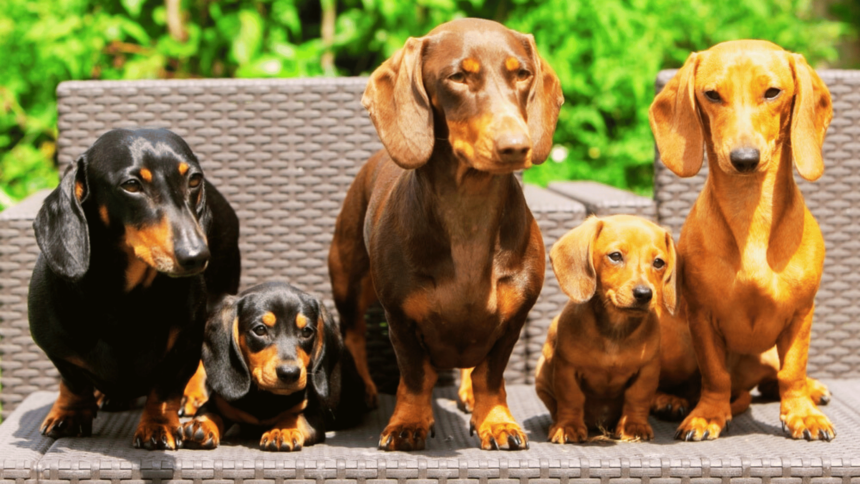Dachshunds, affectionately known as “wiener dogs,” have captured hearts worldwide with their unique appearance and spirited personalities. Whether you’re drawn to their long bodies, floppy ears, or unwavering loyalty, these pint-sized companions are full of surprises. But owning a Dachshund comes with its own set of challenges and rewards.
This guide is your one-stop resource for everything Dachshund from understanding their diverse types to mastering their care and uncovering essential tips for a happy and healthy pup. Whether you’re a first-time dog owner or a seasoned Dachshund enthusiast, you’ll find all the information you need to ensure your furry friend thrives.
Let’s dive into the world of Dachshunds and discover what makes these lovable little dogs so special!
Brief History and Origin of the Dachshund Breed
The Dachshund’s story dates back to 15th-century Germany, where they were bred for a specific purpose: hunting badgers. Their name, which translates to “badger dog” in German (Dachs = badger, Hund = dog), reflects this role.
With their long, low bodies, strong claws, and fearless nature, Dachshunds were perfect for burrowing into dens and confronting prey. Over time, they were refined into three coat varieties smooth, long-haired, and wire-haired to adapt to different terrains and climates.
By the 19th century, Dachshunds began to gain popularity as companions rather than working dogs. They were adored by European royalty, including Queen Victoria, who played a pivotal role in promoting the breed. Today, Dachshunds are beloved worldwide for their distinctive look and charming personalities.
Size, Temperament, and Popularity
Size
Dachshunds come in two main sizes: standard and miniature. Standard Dachshunds typically weigh between 16-32 pounds, while miniatures weigh up to 11 pounds. Their compact size makes them versatile, thriving in both urban apartments and rural homes.
Temperament
Known for their bold and playful nature, Dachshunds have a big personality packed into their small frame. They are intelligent, curious, and fiercely loyal to their families. However, their independent streak and hunting instincts can make them stubborn at times, requiring patience and consistent training.
Popularity
Dachshunds are among the most popular dog breeds globally, consistently ranking high in surveys by organizations like the American Kennel Club (AKC). Their unique appearance, coupled with their affectionate and spirited demeanor, has made them a favorite for families, singles, and seniors alike.
With their rich history and endearing traits, it’s no wonder Dachshunds continue to win hearts across generations!
Different Types of Dachshunds
Dachshunds come in three coat varieties Smooth, Long-Haired, and Wire-Haired and two sizes, standard and miniature. Smooth-coated are sleek and low-maintenance, Long-Haired boast silky elegance, and Wire-Haired have a rugged, wiry texture. Each type has unique grooming needs and personality traits, offering versatility while retaining the breed’s iconic charm, intelligence, and bold spirit. Perfect companions for any lifestyle!
Long-Haired Dachshund
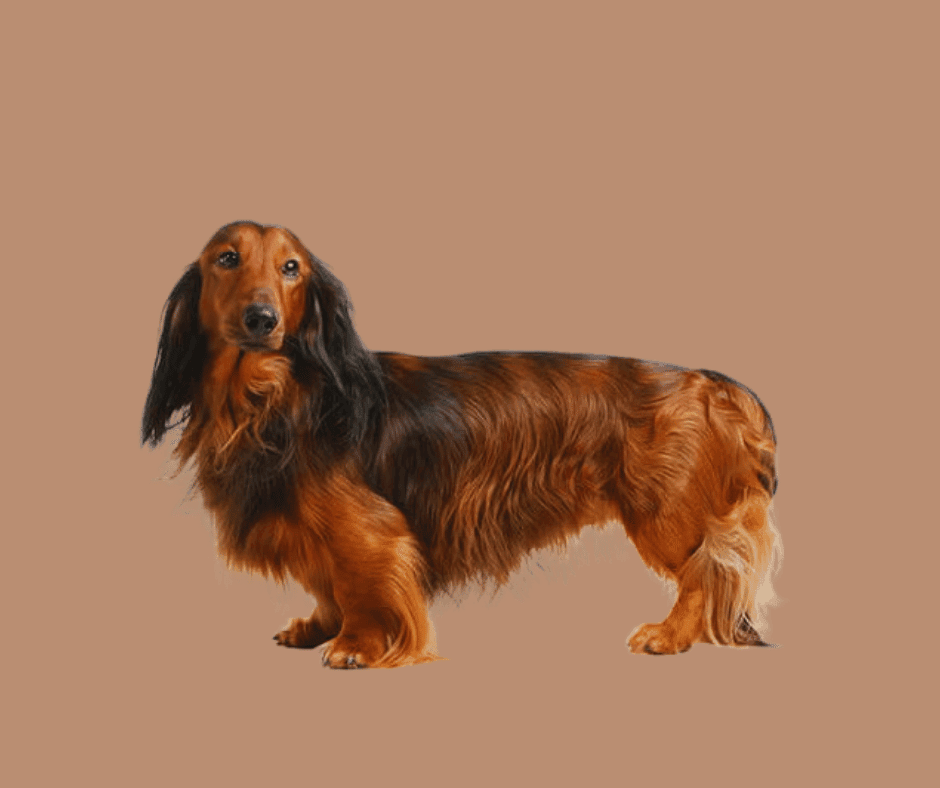
The Long-Haired Dachshund is a stunning variation of this beloved breed, easily recognizable by its silky, flowing coat and elegant appearance. Beneath their luxurious exterior lies the same spirited personality that defines all Dachshunds, making them a favorite among dog lovers.
Grooming Needs and Care Tips
To keep a Long-Haired Dachshund looking its best, regular grooming is essential. Here are some care tips:
- Brushing:
Brush their coat at least 3-4 times a week to prevent tangles and mats, especially around the ears and underbelly. A slicker brush or comb designed for long-haired dogs works best. - Bathing:
Bathe them as needed, typically once a month or when they get dirty. Use a gentle dog shampoo to maintain the softness and shine of their coat. - Trimming:
Trim the fur around their paws and nails to avoid dirt accumulation and discomfort. You may also need to trim long feathers on their tail or legs occasionally. - Ear Care:
Long-haired varieties can be prone to ear infections due to their floppy ears and longer fur. Clean their ears weekly with a vet-recommended ear cleaner. - Shedding:
While they shed moderately, brushing reduces shedding around the house and keeps their coat healthy. - Seasonal Considerations:
During warm weather, ensure they don’t overheat due to their thicker coat. In colder months, their coat provides warmth, but additional protection like a dog sweater may be needed during extreme cold.
The Long-Haired Dachshund’s stunning coat and loving personality make them a joy to have, but they do require commitment to grooming and care. With regular attention, you’ll have a beautiful, happy companion who turns heads wherever you go!
Miniature Dachshund
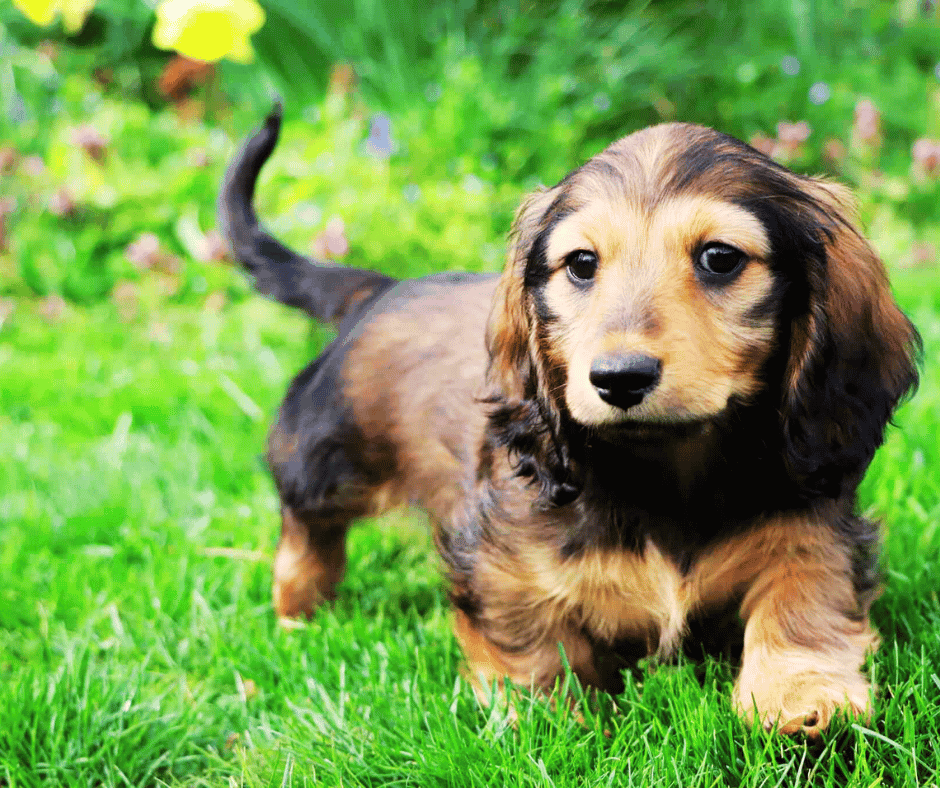
The Miniature Dachshund is a smaller version of the standard breed, yet it retains all the charm, energy, and boldness of its larger counterpart. This pint-sized companion is perfect for those seeking a smaller dog without sacrificing the Dachshund’s iconic personality.
Difference Between Standard and Miniature Dachshunds
Size:
The most obvious difference is size. Miniature Dachshunds typically weigh up to 11 pounds, while Standard Dachshunds weigh 16-32 pounds. Miniatures are also slightly shorter in height and length, making them ideal for apartment living or those with limited space.
Purpose:
Historically, standard Dachshunds were bred for hunting larger prey like badgers, while Miniature Dachshunds were designed to hunt smaller animals such as rabbits.
Size, Care, and Personality Traits
Size:
Miniatures are compact but sturdy. Their small size makes them easier to carry and transport, but it’s essential to handle them with care to avoid injuries, especially to their long spine.
Care:
- Exercise: Miniature Dachshunds may be small, but they have plenty of energy. Daily walks and play sessions are essential to keep them fit and mentally stimulated.
- Diet: Due to their size, they require smaller portions, but care should be taken to avoid overfeeding as they are prone to obesity.
- Health: Like all Dachshunds, miniatures are prone to back issues (IVDD). Avoid excessive jumping, and use ramps to protect their spine.
Personality Traits:
- Loyal: Miniature Dachshunds form strong bonds with their owners and are highly affectionate.
- Playful: They love interactive games and mental challenges, making them fun companions.
- Alert: Despite their size, Mini Dachshunds are excellent watchdogs with a loud, determined bark.
- Stubborn: Their independent nature can make training a challenge, but with patience and positive reinforcement, they learn quickly.
Miniature Dachshunds pack a big personality into a small frame, making them delightful pets for singles, families, and seniors alike!
Dapple Dachshund
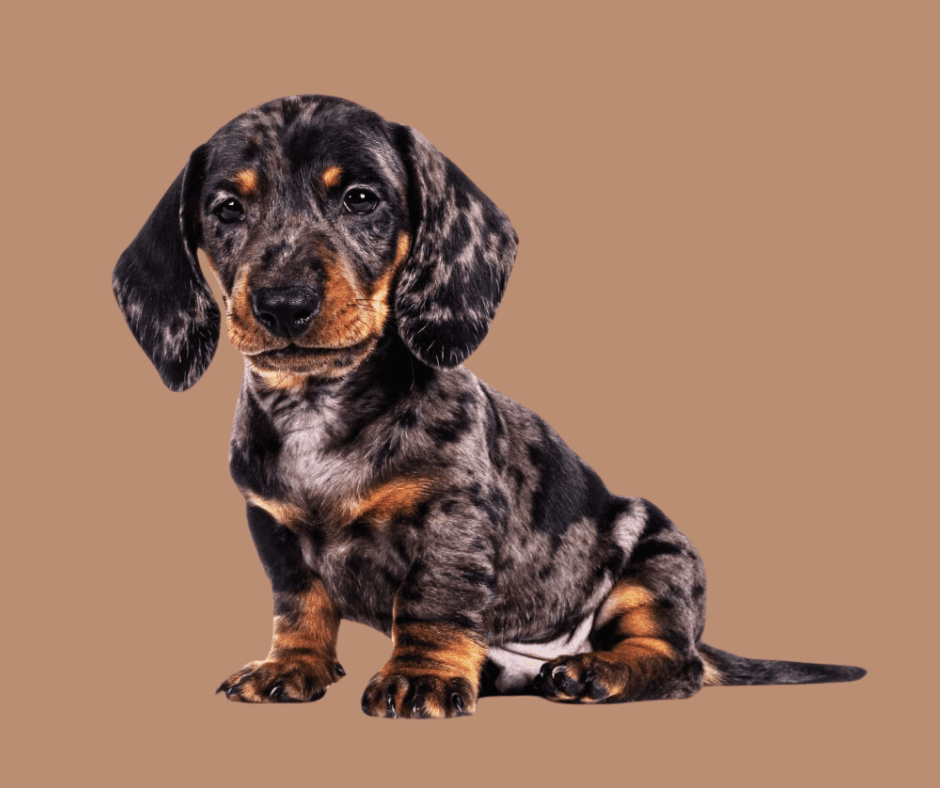
A Dachshund is considered “dapple” when its coat has a unique mottled or marbled pattern, often blending lighter and darker colors such as black, brown, gray, or white. This striking pattern is caused by the merle gene, which can appear in any of the Dachshund’s coat types (smooth, long-haired, or wire-haired) and sizes (standard or miniature).
Special Care Considerations
While dapple Dachshunds are visually stunning, the merle gene requires special attention due to potential health concerns:
- Hearing and Vision Issues: Double dapples (born from two dapple parents) are at risk of congenital deafness and blindness due to genetic complications. Responsible breeding practices are essential to minimize these risks.
- Skin Sensitivity: Light-colored patches in the coat can make their skin more prone to sunburn. Limit direct sunlight exposure or use dog-safe sunscreen.
- Regular Vet Visits: Regular health check-ups are crucial to monitor and address any breed-specific health concerns early.
Despite these considerations, with proper care and awareness, dapple Dachshunds thrive and make delightful companions.
Wire-Haired Dachshund
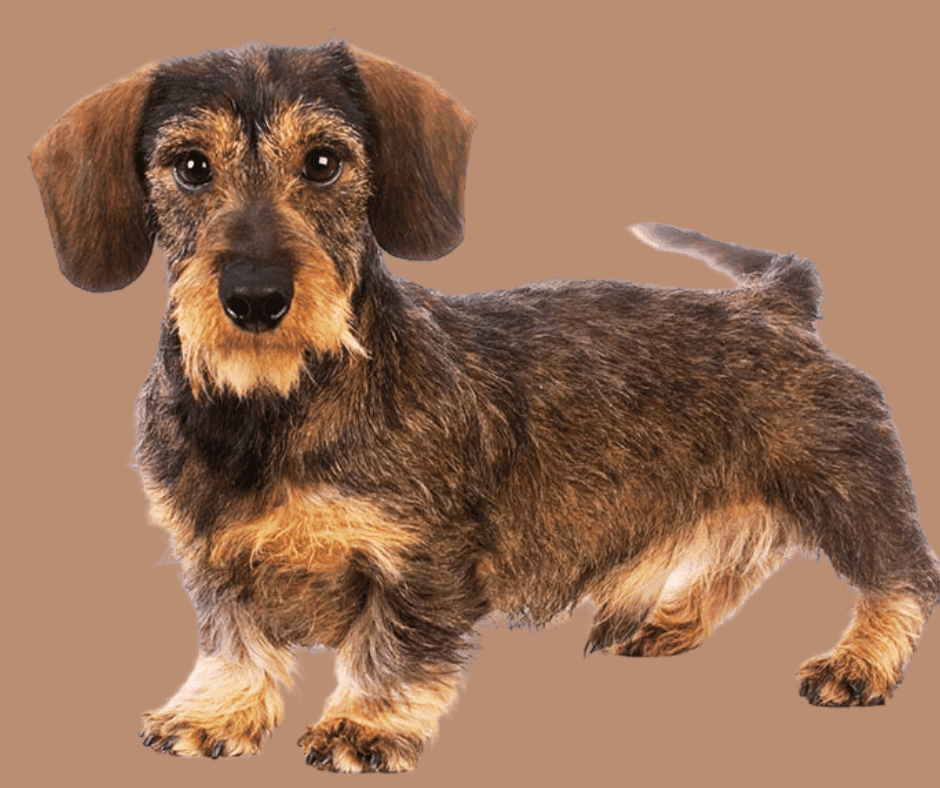
The Wire-Haired Dachshund stands out with its rugged and textured coat, which gives it a charmingly scruffy appearance. This coat type was developed by breeding Dachshunds with terriers to withstand harsher climates and rough terrain. Wire-haired Dachshunds retain the breed’s bold and curious nature but often display a more playful and spirited demeanor, likely influenced by their terrier ancestry.
- Coat Type: Their wiry double coat consists of a coarse outer layer and a softer undercoat. This texture protects them from cold and wet conditions.
- Personality: They are energetic, mischievous, and often more outgoing and extroverted compared to other coat types. Their terrier genes may make them slightly more independent and adventurous.
Grooming Needs
- Brushing: Brush their coat 2-3 times per week to prevent tangles and remove loose fur.
- Stripping: Twice a year, they may require hand-stripping (removing dead hairs) to maintain their coat’s texture and health.
- Bathing: Bathe them as needed with a mild shampoo, but avoid over-washing, which can strip natural oils.
- Ear and Nail Care: Regularly check and clean their ears to prevent infections and trim their nails to keep them comfortable.
With regular grooming, the Wire-Haired Dachshund’s unique coat stays healthy, and their lively personality makes them a joy to have around.
English Cream Dachshund

The English Cream Dachshund is a rare and elegant variety distinguished by its luxurious, cream-colored coat. This shade is usually found in long-haired Dachshunds and is the result of careful breeding with specific recessive genes. True English Creams have a soft, shaded appearance, with some puppies having darker highlights that lighten as they age.
Temperament
- Gentle and Sweet: English Cream Dachshunds are known for their calm, affectionate, and almost regal demeanor. They are often gentler and more easy-going compared to other Dachshund varieties, making them excellent companions for families or individuals seeking a mellow pet.
- Playful and Loyal: Despite their gentle nature, they still retain the breed’s playful and curious traits, thriving on interaction and companionship.
Care Tips
- Grooming: Regular brushing keeps their silky coat tangle-free and shining. Long-haired varieties may need extra care to avoid mats, especially around the ears and chest.
- Exercise: They enjoy moderate activity levels—daily walks and indoor playtime keep them happy and healthy.
- Health: Like all Dachshunds, English Creams are prone to back issues (IVDD). Support their spine with ramps and avoid activities that require jumping.
- Socialization: Their loving nature benefits from early socialization to ensure they remain confident and well-adjusted.
The English Cream Dachshund’s stunning appearance and calm temperament make it a standout in the Dachshund family, perfect for those seeking a graceful yet playful companion.
How to Pronounce “Dachshund”
The word “Dachshund” often trips people up due to its German origins and unique spelling. Understanding the correct pronunciation can help you confidently discuss this beloved breed!
Common Pronunciation Mistakes
Many people mistakenly pronounce it as:
- “Dash-hound”
- “Dash-und”
- “Dack-sund”
These mispronunciations stem from trying to phonetically pronounce the English spelling or associating it with “hound.”
Correct Way to Pronounce “Dachshund”
The proper pronunciation is “Dahks-hund” (like “docks-hund”) in German, where “Dachs” means badger and “Hund” means dog. In English, it is often simplified to “Daks-und” or “Dahks-und.” Both are widely accepted.
Phonetic Breakdown:
- Dachs (Dahks): Rhymes with “locks.”
- Hund (Hoond or Hund): Rhymes with “fund” but with a softer “oo” sound in German.
Audio Guide Suggestion: While I can’t directly provide audio here, you can use language tools like Google Translate. Type “Dachshund” in German, press the speaker icon, and hear its authentic pronunciation!
Mastering the correct pronunciation not only shows respect for the breed’s origins but also makes you sound like a true dog enthusiast.
Caring for Your Dachshund: The Ultimate Guide
Dachshunds are more than just adorable companions; they are spirited, intelligent, and full of personality. But with their unique body shape and bold attitude, these lovable dogs require special care to ensure they lead a healthy and happy life. Whether you’re a seasoned owner or considering adding a Dachshund to your family, this guide covers everything you need to know about caring for them.
Feeding Your Dachshund
A well-balanced diet is the cornerstone of your Dachshund’s health.
- Portion Control Matters: Dachshunds are prone to obesity, which can stress their spine. Feed them according to their weight and activity level. Miniature Dachshunds need smaller portions compared to their standard-sized counterparts.
- High-Quality Food: Opt for small-breed dog food rich in protein, healthy fats, and limited fillers. Puppies require more calories, while seniors benefit from joint-supporting nutrients.
- Limit Treats: Treats are great for training but should not exceed 10% of their daily calorie intake.
Exercise: Keeping Them Active and Fit
Despite their short legs, Dachshunds are energetic dogs that thrive on physical and mental stimulation.
- Daily Exercise Needs: Aim for 30–60 minutes of exercise, including brisk walks and interactive play. This keeps their weight in check and prevents boredom.
- Low-Impact Activities: Protect their spine by avoiding activities like jumping or climbing stairs. Use ramps to help them access furniture or cars.
- Mental Stimulation: Dachshunds are intelligent and love a challenge. Scent-based games, puzzle toys, and basic obedience training are excellent for keeping them engaged.
Grooming Tips for Dachshunds
Dachshund grooming needs vary based on their coat type, but all require regular care to look and feel their best.
- Smooth-Coated Dachshunds: Brush once a week to remove loose fur and maintain shine. Bathe as needed with a gentle shampoo.
- Long-Haired Dachshunds: Brush 3–4 times weekly to prevent tangles and mats, especially around their ears and chest.
- Wire-Haired Dachshunds: Brush 2–3 times weekly and consider professional hand-stripping twice a year to keep their coat healthy and textured.
- Universal Grooming Needs: Trim their nails regularly, clean their ears to avoid infections, and brush their teeth daily or use dental chews to prevent tartar buildup.
Health Care: Prevention is Key
Dachshunds are generally healthy but are predisposed to certain conditions, especially related to their elongated spine.
- Back Problems (IVDD): Intervertebral Disc Disease is common in Dachshunds. Prevent this by maintaining a healthy weight and avoiding high-impact activities.
- Regular Vet Visits: Schedule routine check-ups to catch potential issues early.
- Vaccinations and Preventives: Keep up with vaccinations, flea/tick prevention, and heartworm treatments.
- Oral Health: Small breeds are prone to dental problems, so prioritize dental care.
Training and Behavior Tips
Dachshunds are intelligent but can be stubborn, making consistent training essential.
- House Training: Establish a consistent bathroom schedule and reward success with treats and praise. Patience is key!
- Obedience Training: Use short, fun sessions to teach commands like “sit,” “stay,” and “come.” Positive reinforcement works wonders.
- Barking Management: As natural watchdogs, Dachshunds may bark excessively. Teach a “quiet” command or redirect their attention with toys.
- Socialization: Early exposure to different people, pets, and environments helps curb territorial behavior and builds confidence.
If you’re looking for Dachshund puppies for sale, it’s essential to find a reputable breeder or adoption center to ensure you bring home a healthy and happy pup. Dachshunds, affectionately known as “wiener dogs,” are beloved for their playful personalities, unique appearance, and loyal nature. Here’s what you should know:
Types of Dachshunds
- Coat Varieties: Smooth, Long-haired, and Wire-haired.
- Sizes: Standard and Miniature.
What to Look for in a Breeder
- Health Testing: Reputable breeders provide health clearances for common Dachshund issues like intervertebral disc disease (IVDD).
- Living Conditions: Puppies should be raised in a clean, loving environment.
- Breeder Credentials: Ensure they’re registered with a recognized kennel club like the AKC (American Kennel Club).
Adopting a Dachshund Puppy
If purchasing from a breeder isn’t for you, consider adoption. Many rescue organizations specialize in Dachshunds, offering a chance to provide a loving home to a puppy or adult dog in need.
Preparing Your Home
- Space: Dachshunds adapt well to small spaces but need exercise to stay fit.
- Supplies: Puppy-proof your home, and gather essentials like a crate, leash, toys, and food.
- Training: Early training helps manage their independent streak and prevents behavioral issues.
Common Health Issues in Dachshunds
Dachshunds are wonderful companions, but their unique build makes them prone to certain health issues. Spinal problems like Intervertebral Disc Disease (IVDD) are common due to their long backs, so it’s crucial to limit activities like jumping. Obesity can also strain their spines and joints, so a healthy diet and regular exercise are essential. Dental issues, allergies, and vision problems may arise, but with proper care and routine vet visits, these can often be managed or prevented. Dachshunds are resilient and loving pets, and by staying proactive about their health, you can help them live a happy, active life.
Fun Facts About Dachshunds
Dachshunds, affectionately known as “wiener dogs,” are full of personality and charm! Here are some fun facts about these lovable pups:
- Bred for Hunting: Originally from Germany, they were bred to hunt badgers, and their name means “badger dog” in German.
- Three Coat Types: Dachshunds come in smooth, long-haired, and wire-haired varieties.
- Two Sizes: They’re available in standard and miniature sizes, making them versatile for different lifestyles.
- Famous Fans: Pablo Picasso and Queen Victoria were both fans of Dachshunds.
- Hot Dog Inspiration: The hot dog was supposedly named after them because of their long, sausage-like shape!
Conclusion
Dachshunds are a delightful breed with their unique appearance, playful nature, and loyal personalities. Whether you choose a smooth, long-haired, or wire-haired Dachshund, in standard or miniature size, each variety offers its own charm. Caring for a Dachshund involves regular vet check-ups, a balanced diet, exercise, and proper training to manage their independent streak and ensure a healthy, happy life.
With their big personalities packed into small bodies, Dachshunds are loving companions that bring joy to any home.
If you’ve enjoyed learning about Dachshunds, share this article or explore related content like “How to Train Your Dachshund
FAQs
1. What are the different types of Dachshunds?
Dachshunds come in three coat types: smooth, long-haired, and wire-haired. They also come in two sizes: standard and miniature.
2. How do I care for a Dachshund?
Dachshunds require regular exercise, a balanced diet, and routine vet check-ups. It’s also essential to avoid activities that strain their spine, like jumping from heights.
Are Dachshunds good with kids?
Yes, Dachshunds are typically good with kids, especially if socialized early. However, they can be a bit stubborn, so supervision and training are key.
Do Dachshunds have health problems?
Yes, Dachshunds are prone to certain health issues, including intervertebral disc disease (IVDD), obesity, and dental problems. Regular vet visits and a healthy lifestyle can help manage these.
How long do Dachshunds live?
Dachshunds generally live between 12 and 16 years, with some living even longer with proper care and attention to their health.

